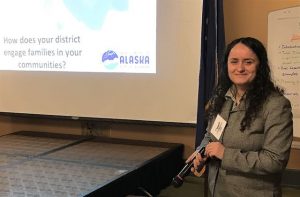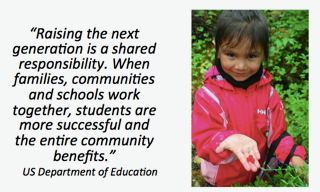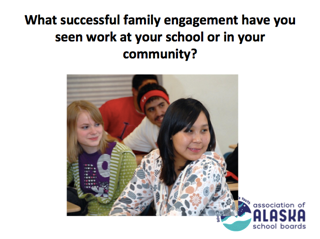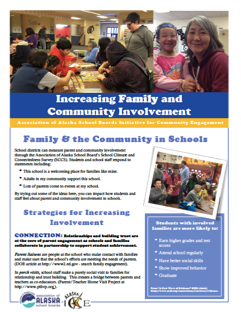Family Engagement Conversation Continues at AASB March Fly-in

By Claudia Plesa, Alaska ICE Community Engagement Educator and Coordinator
AASB’s Fly-in was held March 24-27th in Juneau. It was an opportunity for school board members and superintendents to come together and discuss policy, best strategies for advocating with policymakers, and to learn from each other and AASB staff and presenters.

The Fly-In was an opportunity to continue the conversation started at the Annual Conference on the best ways to engage families in student education. While many educators and school administrators see the benefits of engaging families, there has not always been guidance on how to do this, and how to ensure that students and their families benefit from this type of engagement in a systematic way.
This short article is an overview of:
- Why engaging student families is so important to student outcomes
- How to get started
- Resources and technical assistance available
Why engage families?
Over the past decade, regardless of family income or background, students with involved parents are more likely to:
- Earn higher grades and test scores, and enroll in higher-level programs
- Be promoted, pass their classes, and earn credits
- Attend school regularly
- Have better social skills, show improved behavior, and adapt well to school
- Graduate and go on to postsecondary education
What does Alaskan data say:
- School Climate and Connectedness Survey
- Students who report low family engagement are more likely to have missed school one or more times without permission.
- Students who report low family engagement more likely to have lower grades.
School board members that participated in the March Fly-In were invited to discuss family engagement happening in their school district and activities they have found successful or promising. School board members, school staff, and community members are the ultimate experts in what will be successful in their school or community. They also saw a lot of benefit to family engagement on outcomes for students.
Fly-in board member perceptions of family engagement impacts for students:

- Increase student achievement by linking parents to learning objectives and activities, and allows them to support student study habits
- Provides volunteers from the community for mentoring students
- When parents are involved students do better across the board, even areas outside of academics
- It allows districts to understand student situations and provide additional support if needed.
- Encourages engaged parents to speak out about gaps in school programming, and to work together to fill gaps with community resources
- Allows for greater understanding in the district when decisions are being made related to programming or funding
- Families help link the school to community-based organizations and resources
How do I get started?
Now that we have discussed some of the benefits of family engagement, here are some steps that can get you started:
- Know where you are going:
- What does the School Climate and Connectedness Survey tell you about family engagement?
- What other information is available about family involvement in your schools?
- What do you hope to have happen as a result of family engagement?
- Think school readiness:
- What supports does your district offer for family engagement?
- What do parents of pre-K students need to feel comfortable bringing their children to school for the first time? What about middle school and high school parents?
- How can you link the events to the learning skills kids need?
- Focusing your family engagement efforts:
- How will your engagement activities build trusting relationships with families?
- How will you develop the skills of your staff and families to connect?
- How will you work together to accomplish your goals?
- How can you link classroom learning to your activities?
Resources for Engaging Families
 There are many resources for engaging families, and while they may be effective on their own, it is important to adapt them to the needs of your community, the capacity of your staff and the goals you have set for engaging families in your school or district.
There are many resources for engaging families, and while they may be effective on their own, it is important to adapt them to the needs of your community, the capacity of your staff and the goals you have set for engaging families in your school or district.
The Dual Capacity Framework and the attached PowerPoint, which includes information on adaptations Alaskan communities have made to this framework are a great way to start. AASB’s School Climate and Connectedness & and Community School Climate Surveys are a great tool for knowing how your current efforts are doing, and for measuring engagement activity impact.
Reach out to Alaska ICE for technical assistance on how to use School Climate data to support your family engagement efforts, and for getting started on engaging families and parents in your community. Contact Lori Grassgreen for more information on AASB services related to family engagement.
# # #
View the presentation slides from the Fly-In group discussion co-facilitated by Claudia Plesa and Jenni Lefing about strategies to increase family engagement in schools.
